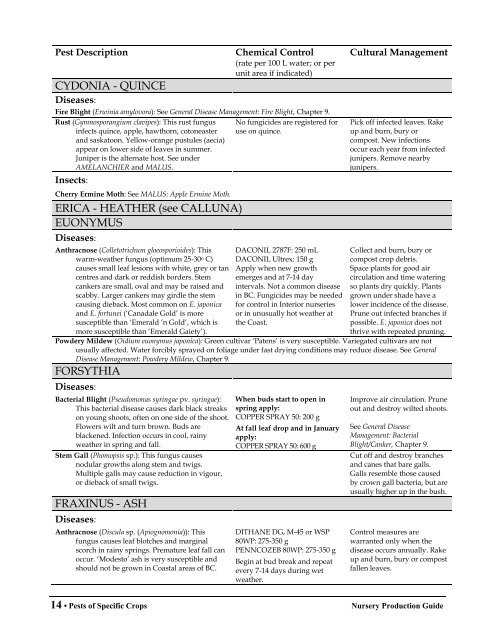Create successful ePaper yourself
Turn your PDF publications into a flip-book with our unique Google optimized e-Paper software.
Pest Description<br />
CYDONIA - QUINCE<br />
Diseases:<br />
Chemical Control<br />
(rate per 100 L water; or per<br />
unit area if indicated)<br />
Fire Blight (Erwinia amylovora): See General Disease Management: Fire Blight, Chapter 9.<br />
Rust (Gymnosporangium clavipes): This rust fungus<br />
infects quince, apple, hawthorn, cotoneaster<br />
and saskatoon. Yellow-orange pustules (aecia)<br />
appear on lower side <strong>of</strong> leaves in summer.<br />
Juniper is the alternate host. See under<br />
AMELANCHIER and MALUS.<br />
Insects:<br />
Cherry Ermine Moth: See MALUS: Apple Ermine Moth.<br />
ERICA - HEATHER (see CALLUNA)<br />
EUONYMUS<br />
Diseases:<br />
Anthracnose (Colletotrichum gloeosporioides): This<br />
warm-weather fungus (optimum 25-30 o C)<br />
causes small leaf lesions with white, grey or tan<br />
centres and dark or reddish borders. Stem<br />
cankers are small, oval and may be raised and<br />
scabby. Larger cankers may girdle the stem<br />
causing dieback. Most common on E. japonica<br />
and E. fortunei (‘Canadale Gold’ is more<br />
susceptible than ‘Emerald ’n Gold’, which is<br />
more susceptible than ‘Emerald Gaiety’).<br />
No fungicides are registered for<br />
use on quince.<br />
DACONIL 2787F: 250 mL<br />
DACONIL Ultrex: 150 g<br />
Apply when new growth<br />
emerges and at 7-14 day<br />
intervals. Not a common disease<br />
in BC. Fungicides may be needed<br />
for control in Interior nurseries<br />
or in unusually hot weather at<br />
the Coast.<br />
Cultural Management<br />
Pick <strong>of</strong>f infected leaves. Rake<br />
up and burn, bury or<br />
compost. New infections<br />
occur each year from infected<br />
junipers. Remove nearby<br />
junipers.<br />
Collect and burn, bury or<br />
compost crop debris.<br />
Space plants for good air<br />
circulation and time watering<br />
so plants dry quickly. Plants<br />
grown under shade have a<br />
lower incidence <strong>of</strong> the disease.<br />
Prune out infected branches if<br />
possible. E. japonica does not<br />
thrive with repeated pruning.<br />
Powdery Mildew (Oidium euonymus japonica): Green cultivar ‘Patens’ is very susceptible. Variegated cultivars are not<br />
usually affected. Water forcibly sprayed on foliage under fast drying conditions may reduce disease. See General<br />
Disease Management: Powdery Mildew, Chapter 9.<br />
FORSYTHIA<br />
Diseases:<br />
Bacterial Blight (Pseudomonas syringae pv. syringae):<br />
This bacterial disease causes dark black streaks<br />
on young shoots, <strong>of</strong>ten on one side <strong>of</strong> the shoot.<br />
Flowers wilt and turn brown. Buds are<br />
blackened. Infection occurs in cool, rainy<br />
weather in spring and fall.<br />
Stem Gall (Phomopsis sp.): This fungus causes<br />
nodular growths along stem and twigs.<br />
Multiple galls may cause reduction in vigour,<br />
or dieback <strong>of</strong> small twigs.<br />
FRAXINUS - ASH<br />
Diseases:<br />
Anthracnose (Discula sp. (Apiognomonia)): This<br />
fungus causes leaf blotches and marginal<br />
scorch in rainy springs. Premature leaf fall can<br />
occur. ‘Modesto’ ash is very susceptible and<br />
should not be grown in Coastal areas <strong>of</strong> BC.<br />
When buds start to open in<br />
spring apply:<br />
COPPER SPRAY 50: 200 g<br />
At fall leaf drop and in January<br />
apply:<br />
COPPER SPRAY 50: 600 g<br />
DITHANE DG, M-45 or WSP<br />
80WP: 275-350 g<br />
PENNCOZEB 80WP: 275-350 g<br />
Begin at bud break and repeat<br />
every 7-14 days during wet<br />
weather.<br />
Improve air circulation. Prune<br />
out and destroy wilted shoots.<br />
See General Disease<br />
Management: Bacterial<br />
Blight/Canker, Chapter 9.<br />
Cut <strong>of</strong>f and destroy branches<br />
and canes that bare galls.<br />
Galls resemble those caused<br />
by crown gall bacteria, but are<br />
usually higher up in the bush.<br />
Control measures are<br />
warranted only when the<br />
disease occurs annually. Rake<br />
up and burn, bury or compost<br />
fallen leaves.<br />
14 • <strong>Pests</strong> <strong>of</strong> <strong>Specific</strong> <strong>Crops</strong> Nursery Production Guide
















